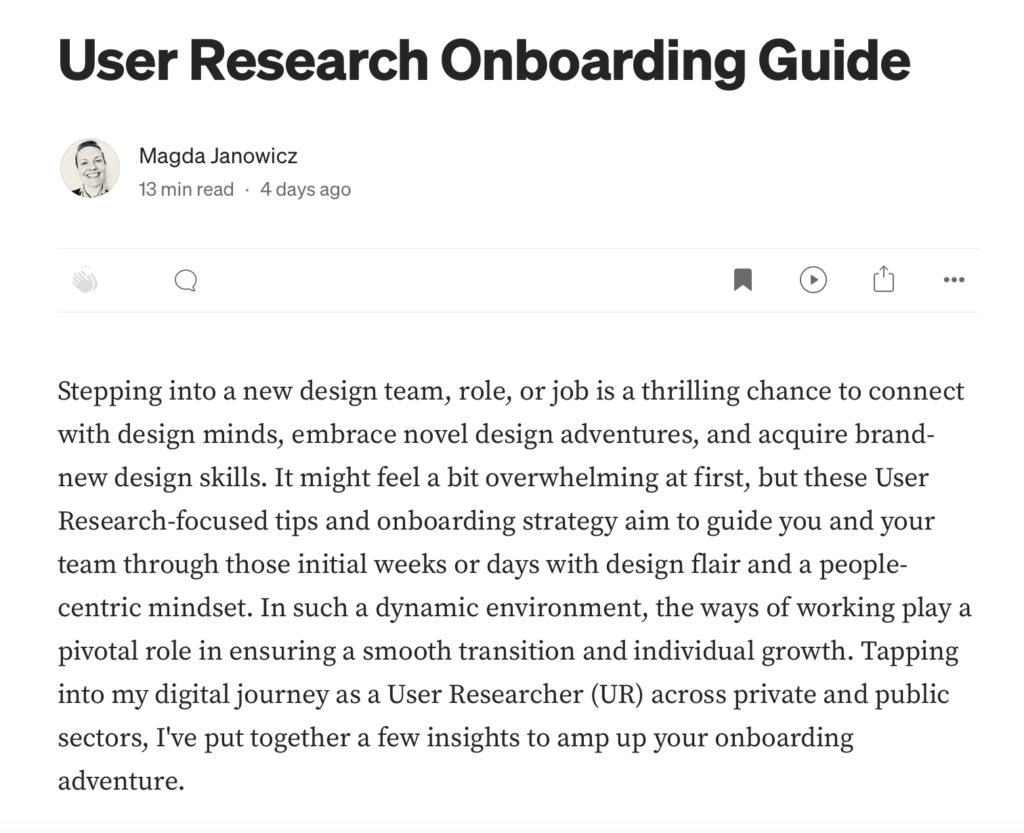Hello! Welcome to my User Research page!
As a user researcher, I’m exploring the connections between technology and society. Holding BSc in Psychology and MSc in Human-Computer Interaction (HCI) from UCLIC, University College London (UCL), I bring a unique blend of expertise to the world of UX.
I’m skilled in guiding the entire user research process, specializing in mixed methods research. I can create both low fidelity physical and rapid digital prototypes quickly and effectively.
With experience collaborating in multidisciplinary teams across private and public sectors as well as startups and a knack for managing small teams, I thrive on untangling new opportunities and identifying gaps, swiftly evaluating ideas for maximum impact.
I have experience in Agile and Waterfall projects as well as GDS framework, specializing in technology implementations and transformations. Experience in partnering alongside 3rd parties to create rapid prototypes, proof of concepts, MVPs, iterations using multiple design models and techniques including HCI and Design Interaction research, and live solutions (private and public).
I believe in the strength of teamwork, encouraging creative thinking, and using User-Centred Design (UCD) communities. Co-design is a method I employ to adapt to diverse contexts, enhancing creativity, innovation, ownership, and maintaining the specific business and project goals, as well as the end-user as the focal points in the design solutions.
My professional journey in UXR centres around comprehending user behaviour and utilising my psychology background to shape inclusive designs. I specialise in social innovation, tech for good, digital health, design and affective interaction, data and AI products, games, education, and championing the cause of accessible and user-centric experiences.
Please view some of my user research projects below. Some details have been modified to protect confidentiality. Hiring Managers: please contact me at [email protected] for my latest UXR work.
COVID-19 rapid home testing made easier for partially sighted people
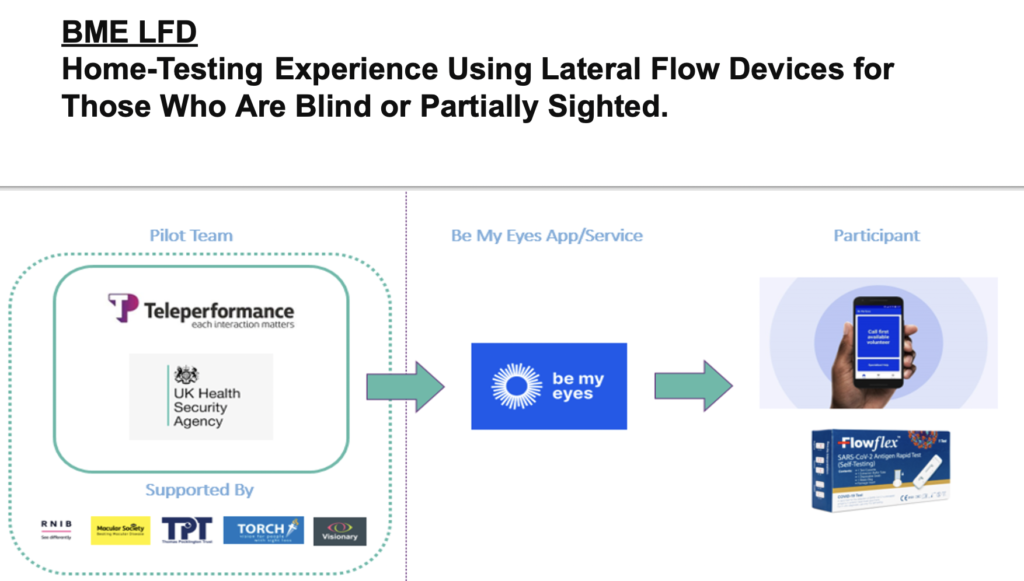
Year: 10/2021-01/2022
Role: Senior UX Researcher
Research Method: Contextual Inquiry + Focus Group + Usability Testing
Research Type: SME, Discovery UR, Usability Trial (Remote), Evaluation
Organisation: UK Health Security Agency (UKHSA)
As a Senior User Researcher, I co-led a pilot project focused on evaluation of COVID-19 self-testing experience of blind and partially sighted people using lateral flow tests at home, conducted by the Home Test Service in collaboration with the BeMyEyes App, the Royal National Institute of Blind People, the Macular Society, the Thomas Pocklington Trust, Visionary and the Torch Trust, has been widely socialised and externally published i.e., Civil Service, UKHSA Case Study, BeMyEyes, and BBCRadio4.
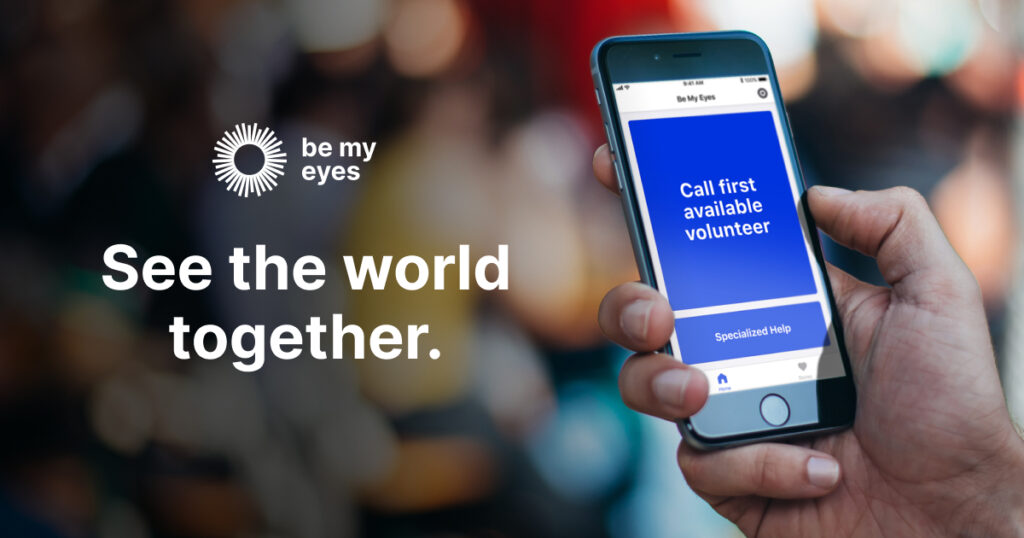
During this period, we conducted eight interview-style sessions focusing on rapid lateral flow at-home testing. Our participants had diverse levels and types of sight loss. The pilot, which successfully completed seven out of the eight trial sessions, benefited from the engagement of volunteer applicants selected to participate.
The primary goal of the pilot was to explore whether assistance through the Be My Eyes service could empower blind and partially sighted individuals to independently perform an LFD test without in-person support.
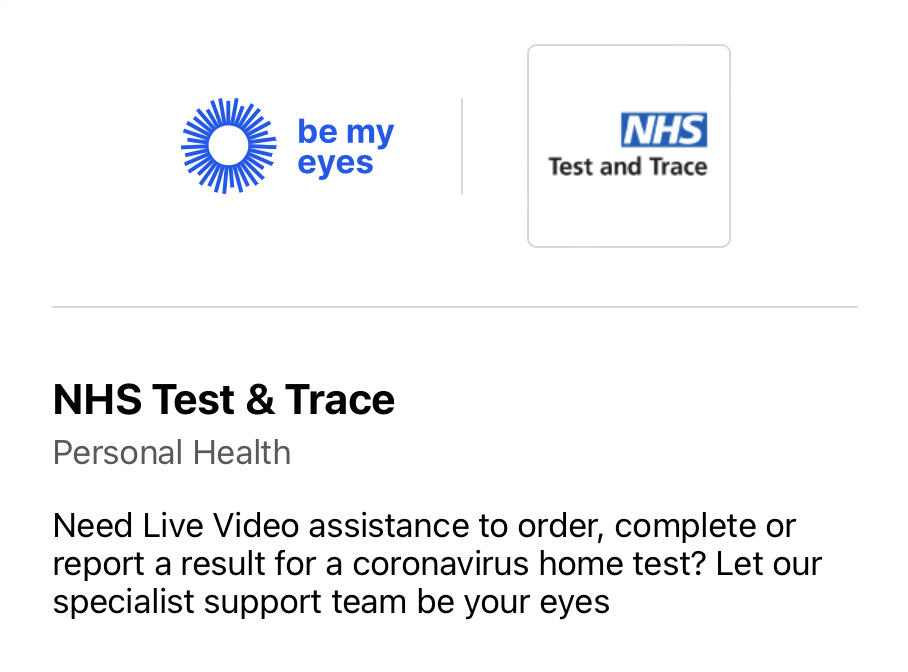
User Insights:
During 5 out of 7 completed tests, the Be My Eyes application (BME) faced challenges in confirming the recommended quantity of drops squeezed into the LFD reader. As reported by a Pilot Observer, the contact centre agent couldn’t confidently verify the drops:
“[The] Participant cannot see if [there are] drops coming out of hitting cassette.”
Users encountered a challenge with the design of the rapid flow device, particularly in adding the precise amount of the test sample into the LFD reader aperture. Both participants and Be My Eyes (BME) observers experienced difficulties in visually assessing the dispensed solution. A Pilot Participant mentioned that without support from the Be My Eyes service, they might have given up:
“I’d have given up [without support from the Be My Eyes Service]. It would have been too much, especially with the dropper and getting 4 drops into that little thing.”
Providing accurate guidance to participants for positioning their mobile device camera during the test, adding drops, reading the result, and recording the batch number proved challenging for Agent support. A 119/Be My Eyes Agent highlighted the difficulties faced in this process:
“It is really hard to see the drops – it looked like it was 4, but it was hard [to see] – [the] participant had a decent camera, but not everyone has a good camera.”
Press Feedback:
Will Butler – the Chief Experience Officer at Be My Eyes:
“Things take a long time when you’re working with big numbers. Unfortunately, accessibility is often deprioritised across the board, whether you’re talking to private companies, or governments but the UK is leading the way here, we don’t have any other government entities or any other major national programmes providing this type of support in other countries and that’s a problem.” BBC Radio 4 – In Touch
“Being blind I am unable to do the test independently but was able to do it with the Be My Eyes service and complete the test on my own for the first time.“ – pilot participant with sight loss
The Pilot achieved key outcomes:
- Boosted trust in UKHSA among the BPS community.
- Enhanced understanding of sight loss experiences for the UK government.
- Actively pursuing accessible test kit products, focusing on reducing liquid measuring requirements and minimising the need for component identification and manipulation.
Implications:
- Thorough testing for new products.
- Initiating UX Research for excluded groups, starting with those with learning/cognitive issues.
- Improved instruction and support implemented and shared across the board for diverse adaptation.
Accessible Voice User Interface – Creative Design Gamification

Year: 11/2019-04/2020
Role: Lead UX Researcher
Research Method: Contextual Inquiry + SME Interviews, Wizard of Oz and Usability with Evaluation
Research Type: HCI mixed methods
My recent research at UCL (MSc in HCI) has centred on inclusive design education, accessibility technology, and makerspace and Do-It-Yourself (DIY) movements. The project partners involve the Global Disability Innovation Hub and Extant Theatre. The project attained a distinction and I’m determined to further reflect upon the process and implement the research findings in practice involving an extended collaboration with the disability community and theatre sector. Project page: www.tinkerprop.com
The study addresses the high unemployment rates and design-based work exclusion faced by blind and partially sighted (BPS) individuals, particularly in prop design for theatre, film, and TV. I designed TinkerProp, a web-based prototype of an accessible voice-user interface (VUI), to help create conceptual proposals for work in the field of prop design. The work has two parts: 1) design of TinkerProp with inputs from 7 experts (4 BPS, 3 non-BPS); 2) usability testing with 8 BPS novice designers. TinkerProp (experimental group) is compared to a traditional digital typing vision-based approach (control group) by using speculative design, gamification of design ideation, and Wizard-of-Oz methods. BPS designers found the prototype engaging and useful for learning prop design knowledge and skills and had increased interest and confidence in gaining employment in prop-making. In addition, a strong positive correlation was found between the two judges’ ratings indicating their mutual agreement favouring the proposals developed with the use of TinkerProp.
This project was an attempt to (re)initiate discourse around accessibility of design-based education and employment among the HCI community in a unique and creative way. Also, the prototyping process behind TinkerProp, lessons learned, and evidence for the possibility of technology to augment training for employment traditionally associated with needing sight were discussed and reported.
The study holds implications for vocational education and inclusive design. Its impact emphasises the importance of incorporating accessible design tools and methodologies into vocational education, fostering a more inclusive and diverse workforce.
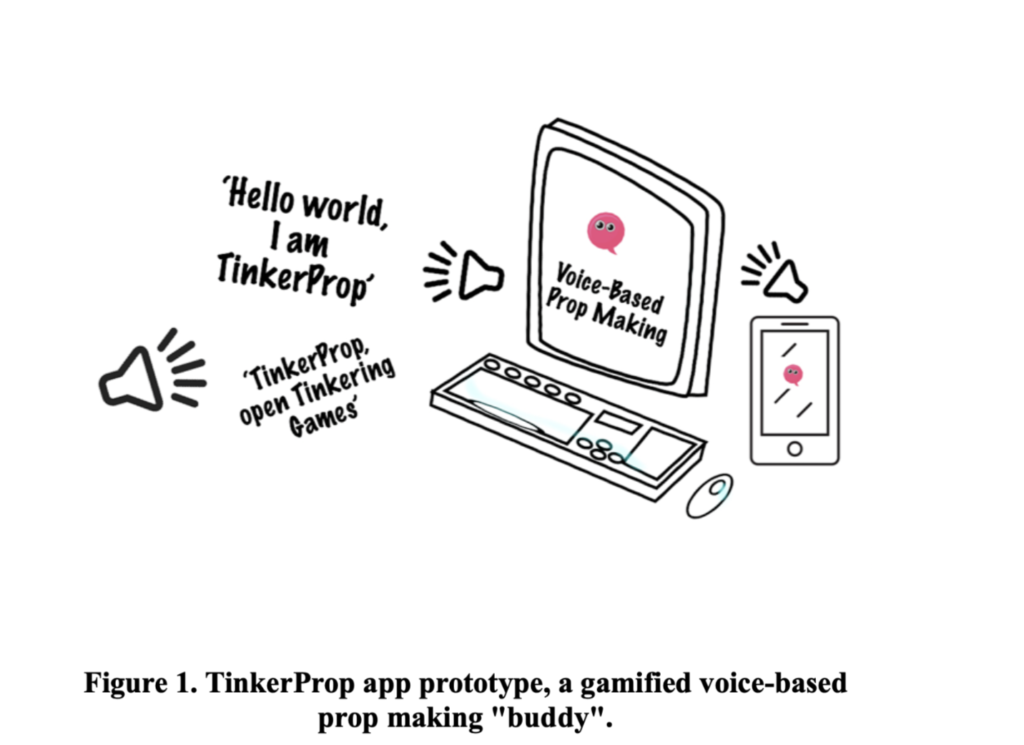
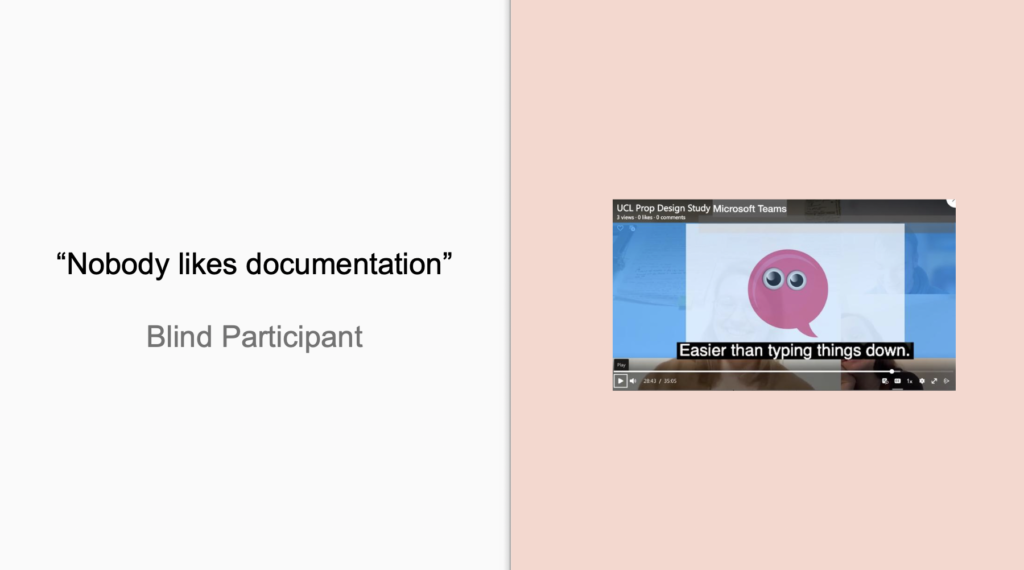
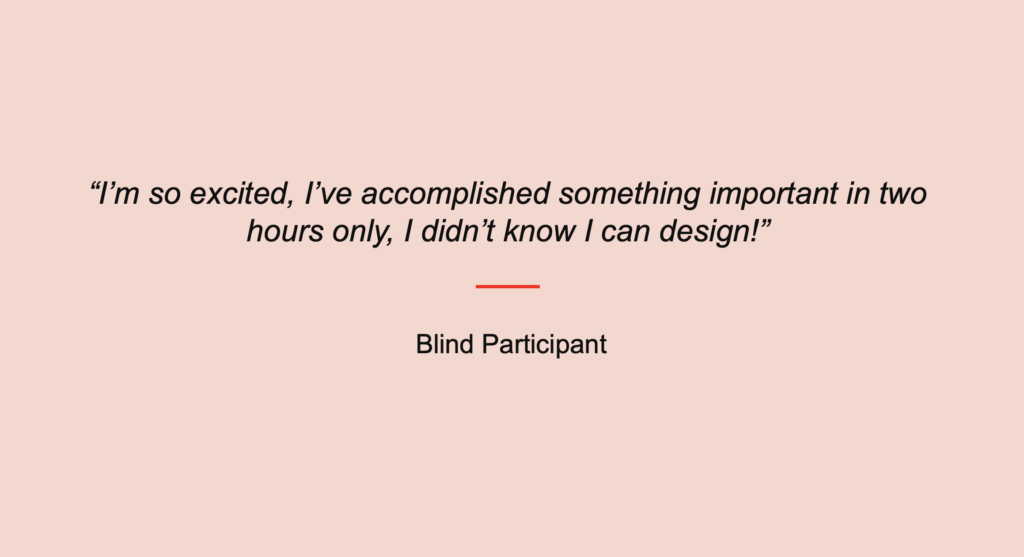
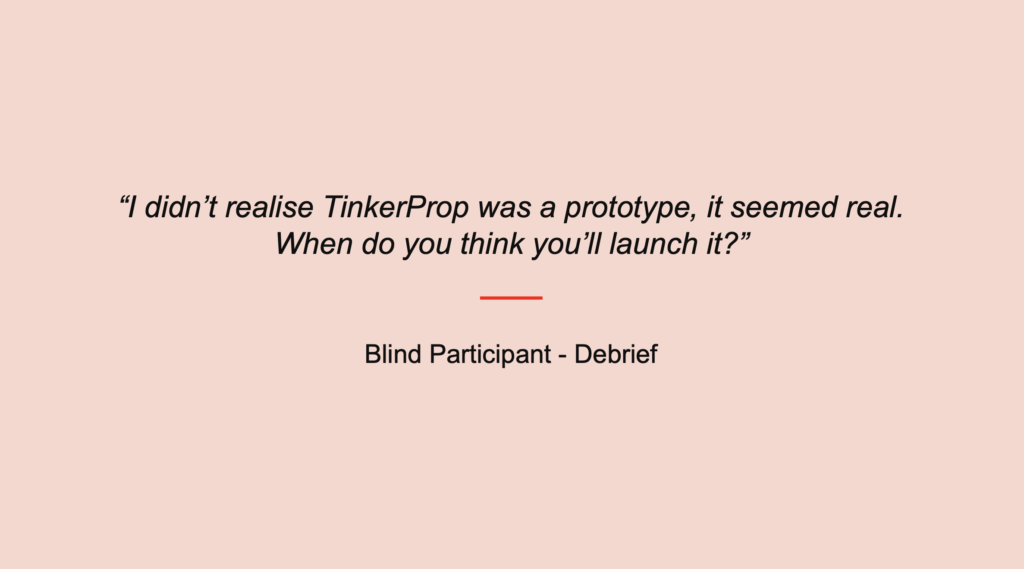
Plans are underway to set up classes for set and prop design at Summer School (UCL – Bartlett and Global Disability Innovation Hub), catering to both blind and partially sighted (BPS) and sighted creatives. The app is considered a valuable, community-owned, and open source tool for education. Collaborations with an educational robotic-apps company, are ongoing to enhance the app and test both audio-only and robot versions. The community and the theatre sector are actively involved in further co-design of TinkerProp, and there are efforts to secure a grant for a theatre show involving BPS designers and the app.
Give Vision – a medical assistive tech device for people with sight loss
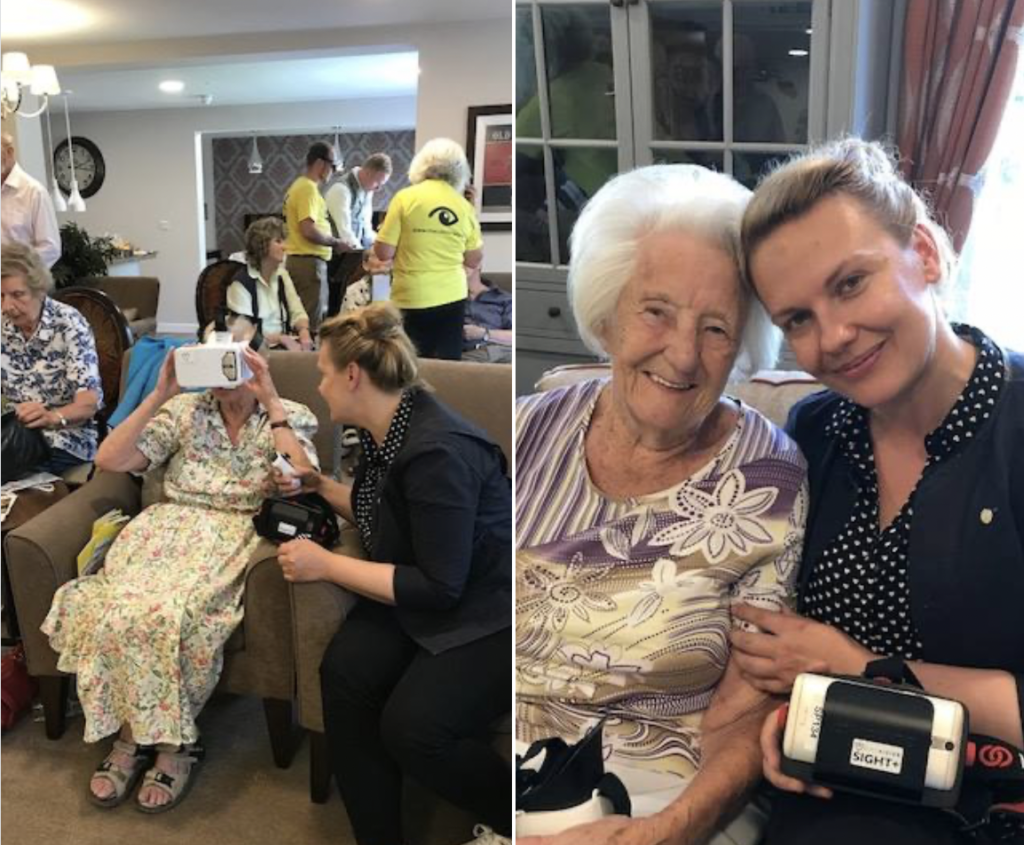
Year: 09/2018 – 06-2019
Role: Lead UX Researcher
Research Method: Usability with Evaluation
Research Type: HCI mixed methods
Company: Give Vision
Give Vision is an award winning startup working on different applications powered by smart glasses to assist visually impaired people in their everyday lives translating visual information into audio in real time and enhancing remaining vision.
In my role as a Lead User Researcher, I spearheaded an end-to-end user research process for the SightPlus wearable vision aid technology by GiveVision. I personally conducted face-to-face sessions and fieldwork, immersing myself in participants’ homes to understand their interaction with the device. To ensure thorough documentation, I invited support User Researchers to take notes, record videos, and observe the sessions. These insights were instrumental in refining our Research and Development efforts. The recruitment of specific participants with visual impairments posed challenges, and to address this, I collaborated with NHS informal communities linked to local hospitals in London. This approach not only enriched our study but also fostered meaningful connections within the community.
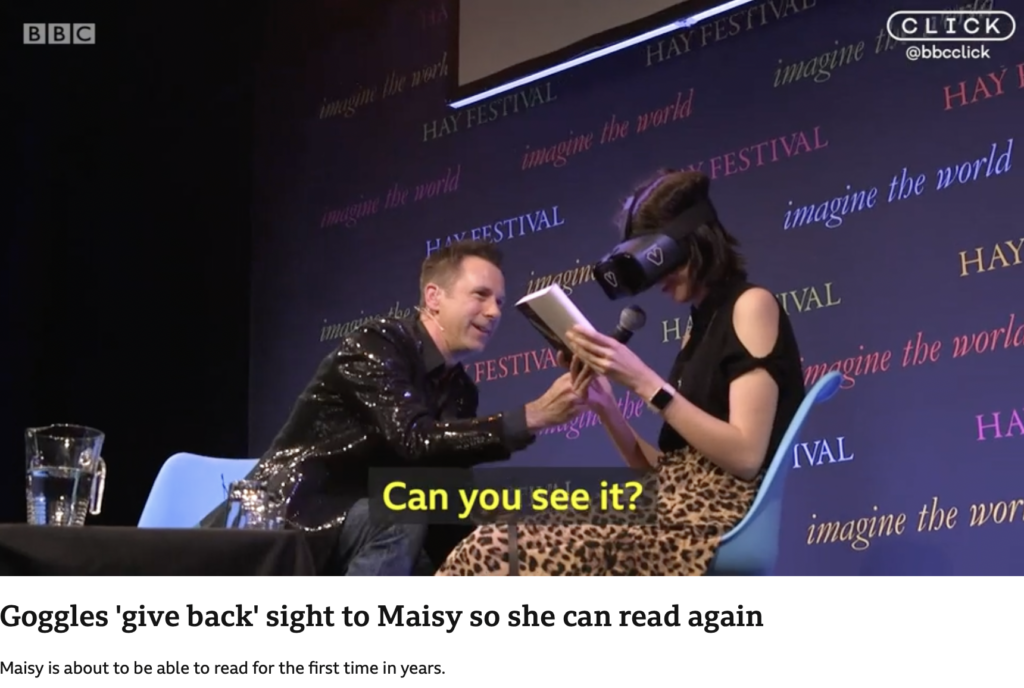
USER RESEARCH BACKGROUND: Since commencing early stage user evaluation sessions with over 1000 visually impaired volunteers in 2016, GiveVision devised a user research evaluation project to provide objective evidence for wearable sight aid SightPlus.
SOLUTION: Three key user research activities were conducted to test and verify the ecological validity of SightPlus while assessing clinically measurable improvements in sight and patient impact.
METHOD:
- Take-home evaluation: Screening and 1:1 demo sessions; After engaging with a number of charities and through exposure on the BBC, GiveVision invited 194 participants to attend a 1:1 demo sessions – 2-week take-home evaluation. Participants were instructed to use SightPlus for any and all activities which they wished to undertake during the two-week period.
- Clinical Validation: Moorfields Eye Hospital NHS Foundation Trust London, UK, sought to assess SightPlus in a clinical setting through a pilot study in partnership with Give Vision and a supporting clinician; Visually impaired volunteers (main indication: central vision loss) participated in an assessment of their vision with and without the SightPlus device.
- Pilot Impact Assessment: A follow up study with the take-home evaluation users to capture further data through validated questionnaires in order to explore sensitivity to changes in participants’ lives; used for a future health economic assessment, partially balancing the SightPlus intervention cohort (n=34) with a control cohort (n=9) to explore volunteer responsiveness and effect sizes.
RESULTS & IMPACT: Outcomes indicated that SightPlus is a versatile sight aid providing lots of flexibility for its use.
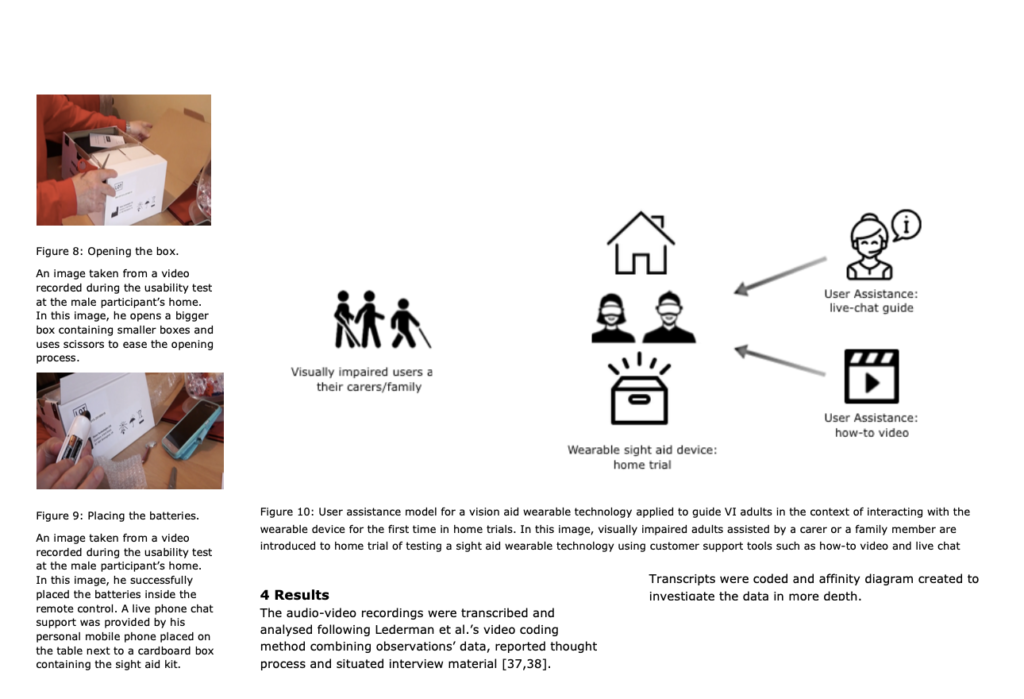
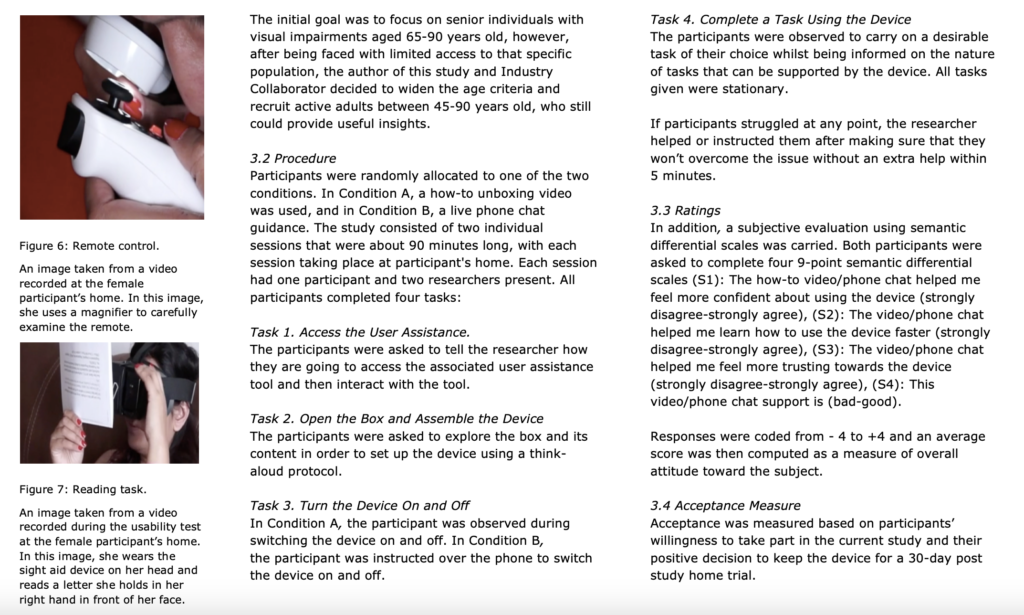
Brand Identity Discovery & Concept Testing
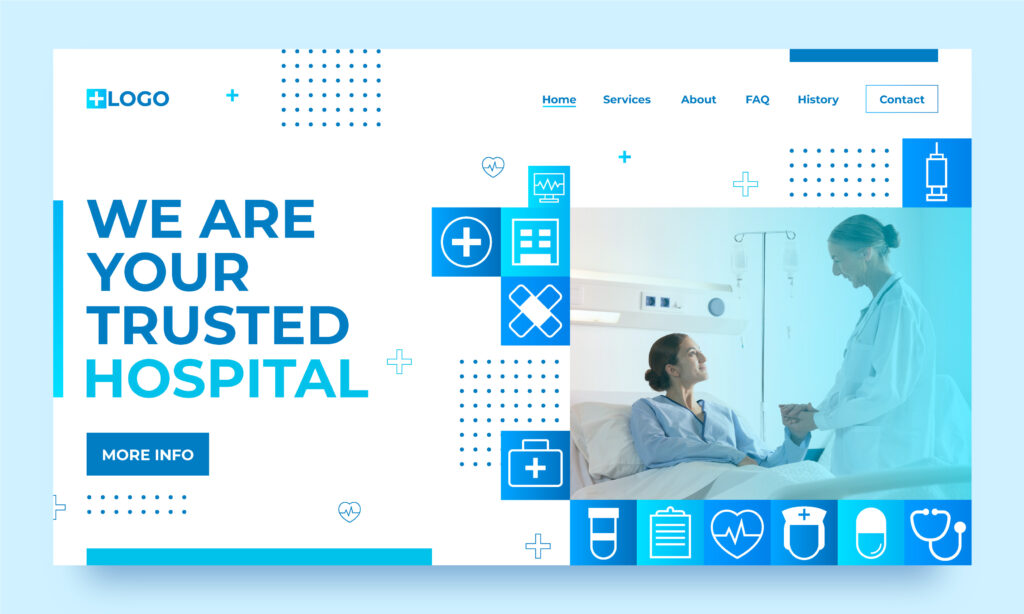
Year: 09/2023 – 10/2023
Role: Principal User Researcher
Research Method: Discovery, A/B testing + Focus Group Research
Company: Cognizant
As a Principal User Researcher, I played a pivotal role in guiding a global private healthcare client through the process of enhancing their brand identity design. This involved employing a comprehensive approach that included A/B prototype testing, survey, and focus groups.
As a researcher I needed to translate insights from client and stakeholder SME workshops, where we delved into their existing knowledge, survey findings, and research objectives. The A/B testing strategy required careful crafting, as it primarily focused on testing concepts, visual aesthetics, and brand perceptions rather than the usability of a finalized product. This subtler approach aimed to gauge reactions to flat designs, compare examples with other brands, and explore attributes that resonated with the target audience.
Taking cues from the insights gathered during the focus group session, we extracted deeper motives and needs within the target group. This multifaceted approach ensured that the A/B testing process was not only aligned with the overarching research objectives but also provided nuanced insights into the audience’s perceptions and attitudes. By working collaboratively with designers and incorporating input from strategists, we were able to create a holistic research framework that addressed both the client’s specific goals and the broader context of user experiences.
Furthermore, my involvement extended beyond traditional user research methodologies. By engaging with marketing professionals within the team, I contributed insights that not only influenced the brand identity but also aligned with broader marketing strategies. This holistic approach ensured a cohesive and user-centric brand experience across various touchpoints, aligning with the client’s goals and creating a meaningful impact.
This involved strategically identifying and inviting individuals who represented the target audience, ensuring diverse perspectives and insights. The recruitment process was carefully tailored to align with the brand’s goals, creating a focus group that effectively reflected the demographic and characteristics of the intended user base.
I made special efforts to involve participants from specific locations, diverse demographics, including LGBTQ+ and disability communities, ensuring a comprehensive and representative sample for the research.
Research Implications:
Through A/B prototype testing, survey, and focus groups, we gained a deep understanding of how millennials and Gen Z and Y perceive the digital brand. The outcomes of these efforts have not only informed the brand digital identity design but have paved the way for significant MVP (Minimum Viable Product) development recommendations. The client now possesses nuanced insights into the preferences and expectations of their target groups. The recommendations made for MVP development are a direct result of this understanding. The next steps included refining and tailoring the digital brand to better resonate with the identified target audience. By implementing these recommendations, the client can enhance their brand’s alignment with user expectations, ensuring a more impactful and successful rollout of their digital healthcare services.
*To comply with my non-disclosure agreement, I have omitted confidential information in this portfolio. Specific case studies under request only.
Read Article – User Research Onboarding Guide
Read Article – Accessible Tech in Employment Hackathon and Talk: Hacking Disability
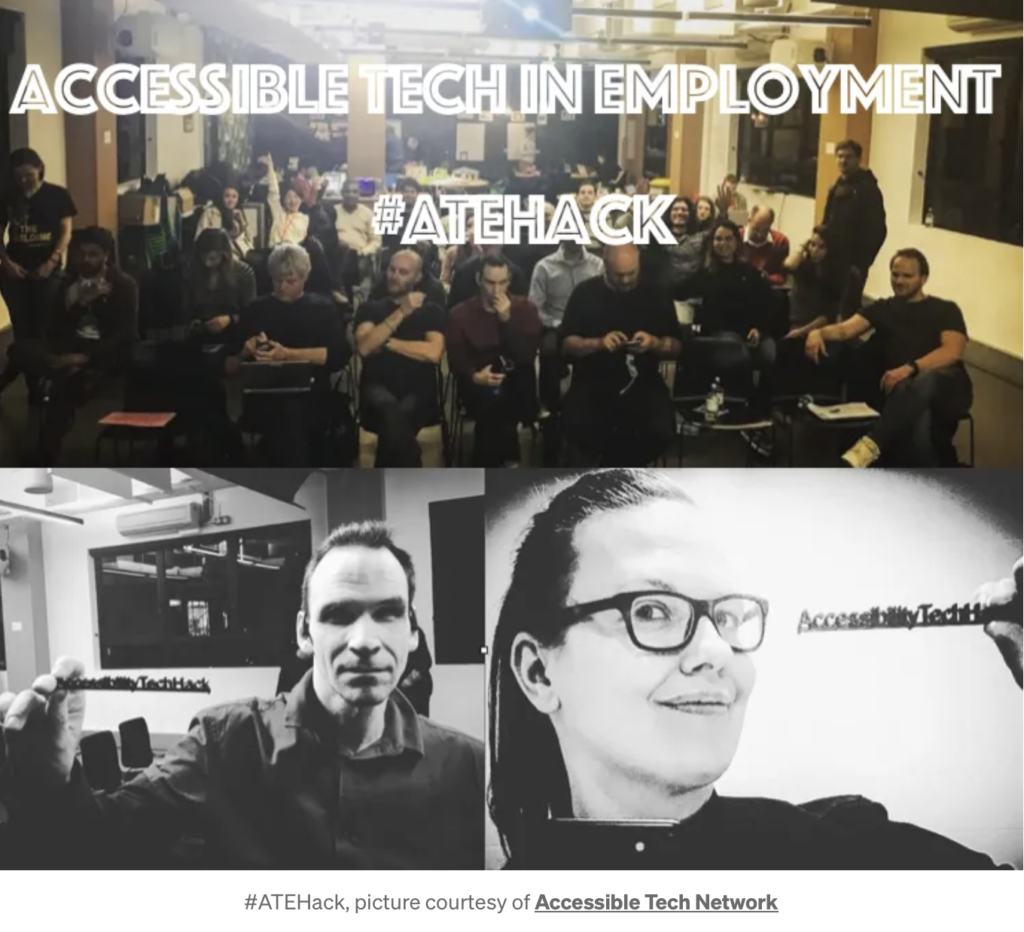
It’s been awesome to see the environment turned digital with beacons, falls buzzed into oblivion, matched employers and employees, navigated hazards on the way to work, recognised colleagues’ faces, matched CVs to jobs via one button, and matching people at networking events! — Vicky Clayton (MakeSense London volunteer)
